Tell Me About It!
Photo#1 Photo#2 Photo#3 Photo#4 Photo#5 Photo#6 Photo#7 Photo#8 Photo#9 Photo#10 Photo#11 Photo#12 Photo#13 Photo#14 Photo#15 Photo#16 Photo#17 Photo#18 Photo#19 Photo#20 Photo#21 Photo#22 Photo#23 Photo#24 Photo#25 Photo#26 Photo#27 Photo#28 Photo#29 Photo#30 Photo#31 Photo#32 Photo#33 Photo#34 Photo#35 Photo#36 Photo#37 Photo#38 Photo#39 Photo#40 Photo#41 Photo#42 Photo#43 Photo#44 Photo#45 Photo#46 Photo#47 Photo#48 Photo#49 Photo#50 Photo#51 Photo#52 Photo#53 Photo#54 Photo#55 Photo#56 Photo#57 Photo#58 Photo#57 Photo#58 Photo#59 Photo#60 Photo#61 Photo#62
Photo
#1
- Ochieng with his 'galimoto.'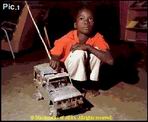
In Luo tradition, children are often named according to the time of day
or the weather which coincides with their birth. For example, Ochieng
is a common boys' name that means 'Day' or 'Sunshine.'
A girl born in the early afternoon of a sunny day might be named Achieng.
Otieno (for a boy) and Atieno (for a girl) indicate that the child was born
at night. Okoth and Akoth are used for children born while it is raining
since 'koth' in Luo means 'rain.'
Have you ever read the book Galimoto by Karen Lynn Williams? A galimoto
is a homemade toy car like the one Ochieng has in this picture.
Amosi, by the way, is Luo (Jambo is 'Hello' in Swahili.)
Photo
#2 - Atieno selling mandazi at the village marketplace.

Atieno (Night), Ochieng's sister, does not go to school, although she
wishes she could. Her family needs her to earn money. So, every morning
she takes her basket full of mandazi, walks to the road where children pass
as they walk to school, and sells the donut-like treats to schoolchildren.
After that, she goes to the market, even when it's not a market day
and sells the rest. She's lucky if she makes the equivalent of fifty
cents a day, but it's enough to by soap, matches and tea for her family.
Mandazi are just like donuts with less sugar and no hole. They make a nice
snack - so even Atieno might sneak a few for herself during the course of
the day.
Photo
#3 - Rocks and hills of Nyanza Province.
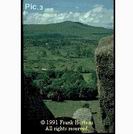
The land surrounding the village of Kodiere (where Ochieng and Atieno live),
on the northern shores of Africa's biggest lake, Lake Victoria, is known
as Nyanza Province. The people there are mostly farmers. Their main crops
are maize, cassava, millet, sukumawiki (like collard greens) and ground
nuts (peanuts). But, from a bird's eye view, as on top of the cliffs
where this picture was taken, one might conclude that their main crop is
big boulders. The area is littered with them - presenting no small problem
to the farmers who have to raise their actual crops around them.
Photo
#4 - A Kenyan jet at the Nairobi International Airport.

Kenya is an East African hot-spot for tourism. Thousands and thousands of
people from all over the world fly there yearly to discover its beauty and
wonder - and to encounter its animals. Some tourists look for large land
animals like lions, elephants and rhinos, while others look for birds. Kenya
has an amazing variety of colorful feathered friends: from hornbills to
ostriches, and from flamingoes to marabou storks. In Swahili, the national
language of Kenya, bird is 'ndege.' And if you're going to look
for ndege in Kenya, you have to fly in on one, too - because ndege can also
mean 'airplane' or 'jet.'
To get to Ochieng and Atieno's village, you would first have to fly
into Nairobi and then take a long bus ride through the Great Rift Valley,
up into the Kenyan Highlands and then down into The Lake Basin of Lake Victoria.
Photo
#5 - Kenya's capital city, Nairobi - from Uhuru National Park
- with The Kenyatta Conference Center tower in the center.
On our trip to Kenya, we're going to a small rural African village to
see what life is like for the children who live there. We'll find that there are plenty
of modern influences in rural Kenyan life, but that many traditional practices
and patterns still hold firm. As we pass through Nairobi, since the international
airport is there, though, we'll recognize that there are parts of Africa
where the opposite is true. In many African cities, there are plenty of
traditional influences, but modern practices and patterns are the rule of
the day.
is like for the children who live there. We'll find that there are plenty
of modern influences in rural Kenyan life, but that many traditional practices
and patterns still hold firm. As we pass through Nairobi, since the international
airport is there, though, we'll recognize that there are parts of Africa
where the opposite is true. In many African cities, there are plenty of
traditional influences, but modern practices and patterns are the rule of
the day.
Nairobi is truly a cosmopolitan city. While rural Kenyan villages are typically
inhabited by people from one ethnic group, Nairobi embraces people from
all forty-two Kenyan ethnic groups, accommodates citizens with European,
Asian, American and Australian ancestry, harbors refugees from neighboring
African countries and hosts tourists from all corners of the globe. As is
true in Washington, D.C., for example, you can walk down a Nairobi street
and hear many different languages.
Photo
#6 - Part of The Great Rift Valley in Kenya.

If you were a giant, something like Gulliver, or Paul Bunyan, or Lolwe -
a giant from Luo mythology who, after drinking copious amounts of beer at
a party one night, formed Lake Victoria the next morning by emptying his
bladder - to you, The Great Rift Valley would be something like a long,
wide and deep ditch - maybe something like your secret playground. You might
splash and bathe in the freshwater lakes that form part of it; or, if you
fancied, make 'pink clouds' by scaring up the hundreds of thousands
of flamingoes that gather on some of its salt lakes. You might dash across
its deserts and frolic in its grassy plains. Just for fun, you might scale
its cliff-like walls or hurdle the volcanic mountains that poke up from
its floor. Maybe you'd snack on the herds of zebra and gazelle that
wander through it.
Then, at the peak of your playful pleasure, your Mom would call you, in
a thundering voice, from your home up and beyond the ridges of the valley:
"Lolweeeeeee, it's tiiiiiime for dinnerrrrrrrr!!!!" And when
you got home and settled at the table for a hearty meal of colossal cassava
pancakes and elephant sausage, she'd probably give you that "How
many times do I have to tell you not to play in that dirty old ditch?"
lecture.
By mere human standards, The Great Rift Valley is a massive geological wonder,
the longest rift on earth - so big it is visible from the moon. It starts
in Jordan (in southwest Asia) where it forms the Dead Sea, then stretches,
in different arms, all the way down the East coast of Africa. In all, it
is 4,000 miles long - as long as the longest river in the world, its East
African neighbor, the Nile - with an average width of thirty to forty miles
(which, of course, is much wider than the Nile). It's a valley so big
that it has giant lakes, mountains, deserts and plains right inside of it!
(Well, giant if you're not a giant, that is.)
Photo
#7 - Stopping Mom for a drink: elephants.

Of course you know that elephants are the largest land animals. But did
you know that they are larger than most other mammals - and most people
- on the very day that they are born? Elephants usually greet the world
weighing over 250 pounds! Well, they ought to: they spend twenty-two months
- almost two full years - inside their mothers before making their grand
entrance! Then, once they're out, they drink their mothers' milk
for another two full years.
Now, it would be unreasonable to think that the youngster in this picture
would show any appreciation for such steadfast care and nurturing; after
all, his only concerns at this point in his life are filling his belly and
playfully romping around the plain with the rest of the herd. But let's
hope that by the time he reaches maturity, at about age sixteen, he shows
her a little respect - maybe gets her a dozen roses or something.
Besides her massive ears and stature, this mother elephant has two protruding
features which clearly identify her as an African, and not an Indian, elephant.
Here's a hint: female Indian elephants wear no ivory.
Photo
#8 - A blur of spots: the cheetah.
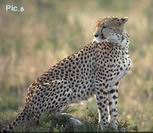
Q: How can you tell a cheetah's spots from a leopard's?
A: They move much faster!
While leopards rely on stealth
to surprise their victims
under cover of the
night
Cheetah's use speed,
committing their crimes conspicuously -
in broad daylight.
The leopard is bigger and stronger, it's true,
with flowery spots on its fur
But the cheetah's fleet feet make it quicker to meat
as its dots turn to stripes in a blur.
Cheetahs are the only felines with claws that don't retract,
using them when running much like sprinters
use spikes
So, unlike their cousins in the cat clan,
when the race is done they don't 'hang
up their Nikes.'
They're alike in one way, nevertheless:
If they catch their prey,
for the rest of the day,
all they do is rest.
Photo
#9 - A gentle and domesticated, albeit BIG-horned, cow crossing
the road.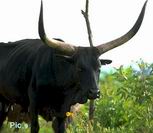
Why do some of the cows in Africa have such huge horns? Well, think about
it, if you were indigenous to Africa, where lions, leopards and hyenas roam
freely, and you were as droopy and slow as a cow, wouldn't you want
big horns, too? Despite its fearsome looking horns, the cow in this picture
is as tame as a housecat. It's a good thing, too. Since all those ferocious
predators are lurking outside, many people in East Africa have a special
place inside their home just for the cows. (Keep in mind that in rural East
Africa, 'home' does not mean the exact same thing it does in other
parts of the world. See Tell Me About It!: Photo
#14 for more information about
the East African definition for the word 'home.')
On most Kenyan roads, pedestrians and motorists have no choice but to yield
to the many four-legged beasts they encounter in their path - most mild,
like cows, sheep and goats; but some wild, most commonly, giraffe and zebra.
Of course, not all of those in vehicles stop in time: so roadkill in East
Africa may have spots and stripes - or, given the size of the beasts with
the spots and stripes, may have license plates and headlights.
Photo
#10 - A tell-tale motif: the zebra.

Zebras are herbivores: they eat grass. Lions are carnivores: they eat zebras.
To avoid being eaten, herbivores need some kind of built-in protection from
carnivores. Antelopes, for example, have great speed, amazing leaping ability,
horns and camouflage. Zebras, on the other hand, have modest speed, little
leaping ability, no horns and one of the most recognizable coat patterns
in all the animal kingdom. So, how do they avoid the teeth of the lion?
Well, they congregate.
Some scientists suggest that when a bunch of zebras stand close together,
with all those zigs and zags blending into each other, lions may see them
as one giant striped beast and avoid them as they might an elephant. Their
strength, as the saying goes, is in their numbers - and if that fails, they
kick!
(Beep-beep. "Come in Mangled Mane. This is Ferocious Fang reporting
from due East of the big baobab tree. Do you copy? Come back."
"Ten four, good 'n bloody. I copy. Go ahead, Mangled Mane."
"Yeah, Ferocious Fang, looks like we've got a massive black and
white trunkless striped elephant heading under the big baobab tree to get
some shade. As far as I can tell from my angle, it's much too big to
warrant attack. I suggest we move on and look for some smaller game down
by the waterhole. Over. Ya read."
"I read ya, Mangled Mane. Acknowledged and agreed. Move 'em out!
Maybe we'll find ourselves a zebra over there.")
Photo
#11 - Fishing in the Great Lake - Victoria.
Lake Victoria, called Lake Nyanza by most Kenyans and Lake Lolwe by Luos,
is the biggest lake in Africa and the source of the longest river in the
world, the Nile. The Nile flows north starting in Jinja, Uganda, and travels
all the way to Cairo, Egypt, where it empties into the Mediterranean Sea.
Did you know that Lake Victoria is one of The Great Lakes? Let's see,
HOMES: Huron, Ontario, Michigan, Erie, Superior - no Victoria there! Ah,
yes, but that's because those are The Great Lakes of North America;
but Africa has a set of its own Great Lakes. Lake Victoria is the largest
of them, but they also include Lakes Tanganyika, Nyasa, Kyoga and Albert.
Can you come up with an acronym for them?
Only one of the North American Great Lakes is larger than Lake Victoria?
Can you name it? These two take first and second place in the world
in the largest fresh water lakes category.
Photo
#12 - Rocks and hills of Nyanza Province.

Big rocks are everywhere around Ochieng and Atieno's village. One of
the large rocks in Nyanza Province, according to legend, is none other than
folk hero Lwanda Magere. Lwanda was a nearly invincible warrior who had
won many glorious victories for the Luo against their enemy neighbors, the
Lang'o; that is, until Lwanda married a beautiful Lang'o woman who
discovered his weakness. Lwanda's Lang'o wife found out that, while
his body was as impenetrable as rock, he would bleed like a normal man if
his shadow were pierced. Returning to her homeland, the wife, unfaithful
to her husband but faithful to her people, revealed the secret of Lwanda.
The Lang'o attacked the Luo and, after an epic battle, a Lang'o
warrior managed to thrust a spear deep into the shadow of Lwanda Magere.
Lwanda died and instantly turned into a giant rock which still stands in
that very place (according to the story) and brings good luck to all hunters
who sharpen their weapons upon it.
Photo
#13 - Pet? More like pest!: the vervet monkey.

The vervet is a common East African monkey. It can be found almost anywhere
in the region where there is food that can be stolen. Vervets prefer whatever
fare they can find in the foliage of wild fruit trees; but if there are
people nearby, it means there are also gardens nearby and domesticated fruit
trees - and grains and crackers and other such delicacies. So, the mischievous
critters can't resist an occasional raid, which in turn is met by the
protective rage of watchdogs. The barking sends the furry burglars running
- but only until the dust settles and they get a hankering for human goodies
once again. You might think that vervets would make cute pets, but according
to the people who share space with them, they're a noisy nuisance -
and nothing more than thieving pests.
Photo
#14 - Say 'hodi' at the gate.
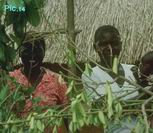
A traditional Luo home is not the same as a house. In fact, it might consist
of many houses - and a special place where animals are fenced in to protect
them from the predators of the night (and, in the old days, from cattle
rustlers). A larger fence, usually made of trees, surrounds the whole complex.
By the way, when you get to the gate, say 'Hodi' (pronounced Hoe-dee)
and someone will warmly welcome you in. Everyone will be very pleased to
see you. Expect to stay for a while.
Photo
#15 - A home is not just a house in Luo tradition.
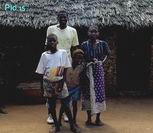 Once
you get in the gate, you'll quickly notice how Luo homes are different
from other homes. You'll see a large compound consisting of between
five and twenty-five thatched houses. Each adult member of the family has
his or her own house. In some families, that might include the houses of
the grandparents, the parents and some uncles and aunts. If the man of the
home has more than one wife, each wife builds her own separate house. Children
sleep in the houses of their mother, but can go from house to house during
the day. When the boys reach their mid-teens, they build their own houses
in the compound. Girls are the only ones who don't get a house in their
original home. They build their houses in the home of their husband.
Once
you get in the gate, you'll quickly notice how Luo homes are different
from other homes. You'll see a large compound consisting of between
five and twenty-five thatched houses. Each adult member of the family has
his or her own house. In some families, that might include the houses of
the grandparents, the parents and some uncles and aunts. If the man of the
home has more than one wife, each wife builds her own separate house. Children
sleep in the houses of their mother, but can go from house to house during
the day. When the boys reach their mid-teens, they build their own houses
in the compound. Girls are the only ones who don't get a house in their
original home. They build their houses in the home of their husband.
Photo
#16 - A Luo homestead.

Inside Ochieng and Atieno's homestead, besides all those houses, there
are several granaries (which look like little houses and hold grain),
a fenced area for keeping the animals at night, a few mango trees and an
area which is reserved for burying any members of the family who pass away.
Outside the fence, there are large gardens and patches of banana, avocado,
orange and eucalyptus trees. A few dogs and their puppies mill around the
compound, some cats lazily lounge here and there and lots of chickens peck
all about.
Photo
#17 - Keeping it cool - with mud.
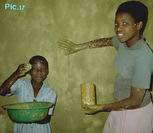 Just the thought of a house made of mud might make one think that such a
place could not be clean. Mud is dirt mixed with water - and dirt, by its
nature, is dirty. But bricks are made of dirt and so is cement - and most
people wouldn't consider houses made of those things to be dirty. The
mud people use to make African houses turns hard - like bricks or cement
- when it dries. Once dry, people often paint their houses - sometimes with
traditional patterns and motifs. So, African houses are clean - as long
as the people who live in them do the housecleaning! An added advantage
of mud is that it keeps the inside of the houses nice and cool during the
hot dry season.
Just the thought of a house made of mud might make one think that such a
place could not be clean. Mud is dirt mixed with water - and dirt, by its
nature, is dirty. But bricks are made of dirt and so is cement - and most
people wouldn't consider houses made of those things to be dirty. The
mud people use to make African houses turns hard - like bricks or cement
- when it dries. Once dry, people often paint their houses - sometimes with
traditional patterns and motifs. So, African houses are clean - as long
as the people who live in them do the housecleaning! An added advantage
of mud is that it keeps the inside of the houses nice and cool during the
hot dry season.
Photo #18 - A cool drink in a cool house for
the guest.
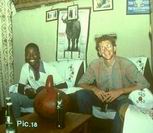 If you were to visit a traditional East African home, your host would proudly
invite you into the home's guest house. Since the home consists of many
small houses, each like the room of its occupant, this guest house is the
equivalent of the living room. Here, you'll be served tea, or in some
homes, soda. While you relax and chat inside, there may well be a
flurry of activity outside, as the mother of the family and the children
chase down, slaughter and cook a chicken - to be served in honor of the
home's special guest: you!
If you were to visit a traditional East African home, your host would proudly
invite you into the home's guest house. Since the home consists of many
small houses, each like the room of its occupant, this guest house is the
equivalent of the living room. Here, you'll be served tea, or in some
homes, soda. While you relax and chat inside, there may well be a
flurry of activity outside, as the mother of the family and the children
chase down, slaughter and cook a chicken - to be served in honor of the
home's special guest: you!
Photo #19 - Take it slow - the African way.
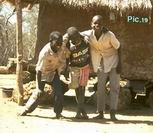 When you visit a home in Ochieng and Atieno's village, you should not
plan to say 'hello' and then hurry off. If you are a special guest
who only visits rarely, the hosts will expect you to 'budho' (as
they say in Luo) - which means to stay and visit for a nice long time. In
Kenya, people often say, 'Hakuna matata,' which means 'no worries
or 'no problem.' When you visit, your hosts will use this term meaning,
don't worry about anything else, just stay and enjoy your visit.
When you visit a home in Ochieng and Atieno's village, you should not
plan to say 'hello' and then hurry off. If you are a special guest
who only visits rarely, the hosts will expect you to 'budho' (as
they say in Luo) - which means to stay and visit for a nice long time. In
Kenya, people often say, 'Hakuna matata,' which means 'no worries
or 'no problem.' When you visit, your hosts will use this term meaning,
don't worry about anything else, just stay and enjoy your visit.
Photo #20 - Don't touch this one: Grandma's
house.
 In Luo tradition the grandmother was - and is - the storyteller, though
these days most children like Ochieng and Atieno learn traditional African
stories in school. In the old days, before modern schools, the grandmother
was like today's teacher, for she taught many lessons through the telling
of her tales. In the evenings, after the sun went down, children would take
their sleeping mats and gather on the floor of the grandmother's house
to listen to stories before bed. When the stories were over, the children
went to sleep right there.(See the next 'Tell Me About It' to read
why you should not disturb the grandmother's house after she has died.)
In Luo tradition the grandmother was - and is - the storyteller, though
these days most children like Ochieng and Atieno learn traditional African
stories in school. In the old days, before modern schools, the grandmother
was like today's teacher, for she taught many lessons through the telling
of her tales. In the evenings, after the sun went down, children would take
their sleeping mats and gather on the floor of the grandmother's house
to listen to stories before bed. When the stories were over, the children
went to sleep right there.(See the next 'Tell Me About It' to read
why you should not disturb the grandmother's house after she has died.)
Photo #21 - Grandparents get great respect in
Luo tradition.
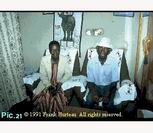
Many Luo people still show a special respect for the grandmother, the teacher
and storyteller, by keeping a tradition that deals with her house. The tradition
says that after the grandmother of a family dies, no one should live in
her house, nor even disturb her house. The house is left to fall apart and
meld with the ground slowly over the years. Some Luo people believe that
if someone does disturb the grandmother's house, the grandmother's
ghost will haunt that person.
Photo #22 - Center stage in the family circle:
the cow.
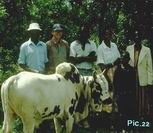
You might notice that many African cows have humps on their backs, not unlike
another African beast of burden, the camel. In East Africa, where dry seasons
can stretch for months without producing rain, the fat in the cow's
hump provides that extra boost of energy that will allow the cow to see
those dry days through till the grass turns green again.
Photo #23 - Laughing prowler of the night: the
hyena.
 Of all the wild animals in Africa, the hyena probably has the worst reputation.
In countless traditional tales, it is pegged as a bloodthirsty, greedy,
slow witted and evil thief. Maybe it's because hyenas have stolen -
and eaten - so many domestic animals of rural Africans over the centuries.
Hyenas also figure prominently in traditional superstitious beliefs. Luo
people, for example, may, jokingly or seriously, depending on the individual,
claim that if a hyena's laughter is heard in the village, a man will
soon die; and that whenever there is a rainbow, hyenas are getting married.
Of all the wild animals in Africa, the hyena probably has the worst reputation.
In countless traditional tales, it is pegged as a bloodthirsty, greedy,
slow witted and evil thief. Maybe it's because hyenas have stolen -
and eaten - so many domestic animals of rural Africans over the centuries.
Hyenas also figure prominently in traditional superstitious beliefs. Luo
people, for example, may, jokingly or seriously, depending on the individual,
claim that if a hyena's laughter is heard in the village, a man will
soon die; and that whenever there is a rainbow, hyenas are getting married.
Photo #24 - Lounging in the limbs: a leopard.
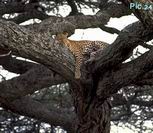
Leopards are like the Stealth Bombers of the African wild. Solitary, sleek
and ferociously powerful, they nonetheless can appear from nowhere to drop
the bomb on their unsuspecting victims. At times the leopard will even attack
from the skies, as it were. Blending into the bark of a sun-spotted tree,
the silent assassin waits for its prey to walk peacefully along a path below
the branch upon which it hovers. Hold tight - target in sight... Zeroing
in on prey.... Three, two, one - bombs away!
Photo
#25 - Masai herdboys.
 The Masai are the East African neighbors of the Luo - and expert herdspeople.
In Luo and Masai tradition, the men and boys have the responsibility of
caring for the animals. Since cows are highly prized, the job has its rewards;
but it can also be downright dull at times. Have you have ever tried leading
(and following) a herd of animals and watching them eat grass all day? Not
very exciting. So boys often play games, like soccer or checkers, sing songs
and chants, quiz each other with riddles, or find other amusements, like
shooting at birds with homemade slingshots, while they are herding. Even
while playing, though, they always have to be aware of where the cows are
and what they are eating. If the cows happen to sneak into a neighbor's
garden, for example, and snack on the crops growing there, the boys will
be in BIG trouble and their father may have to pay a fine.
The Masai are the East African neighbors of the Luo - and expert herdspeople.
In Luo and Masai tradition, the men and boys have the responsibility of
caring for the animals. Since cows are highly prized, the job has its rewards;
but it can also be downright dull at times. Have you have ever tried leading
(and following) a herd of animals and watching them eat grass all day? Not
very exciting. So boys often play games, like soccer or checkers, sing songs
and chants, quiz each other with riddles, or find other amusements, like
shooting at birds with homemade slingshots, while they are herding. Even
while playing, though, they always have to be aware of where the cows are
and what they are eating. If the cows happen to sneak into a neighbor's
garden, for example, and snack on the crops growing there, the boys will
be in BIG trouble and their father may have to pay a fine.
Photo
#26 - The cow - a symbol of wealth.

Got cows? Then you're rich. In rural Africa, more than any other piece
of property, cows are a symbol of a family's wealth. If you have a large
and healthy herd, well, you're the man, so to speak. But, these days,
there is one thing that people value even more than their cows: education.
In fact, since education is not free in Kenya, families will often sell
a cow or two in order to pay the fees which gain their children admittance
to school.
Photo
#27 - Digging in the shamba.
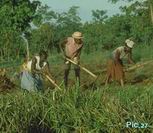 While
men and boys are traditionally the caretakers of a family's animals,
woman are the caretakers of the home and the large gardens that surround
the home, called shambas. At the beginning of the rainy season though, men
often help their wives to dig and plant the gardens. They usually do the
digging by hand, with a large hoe called a 'jembe' (pronounced jaym-bay).
The children will also help in the gardens when it is time to weed or water
the crops and when it's time to harvest.
While
men and boys are traditionally the caretakers of a family's animals,
woman are the caretakers of the home and the large gardens that surround
the home, called shambas. At the beginning of the rainy season though, men
often help their wives to dig and plant the gardens. They usually do the
digging by hand, with a large hoe called a 'jembe' (pronounced jaym-bay).
The children will also help in the gardens when it is time to weed or water
the crops and when it's time to harvest.
Photo #28
- A bunch of bananas.
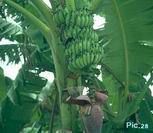
Flowers are beautiful, but they can also be a sign of good things to come
- as in the case of fruit. In northern climates, spring blossoms on fruit
trees eventually turn into autumn food. In the tropics, fruit trees bloom
all year round (some at different times of the year or according to rain
patterns); and when the large purple flower of the banana tree (seen at
the bottom of this picture) pops up, it means that bananas - a whole bunch
of them - will pop up right behind it. The only problem is, as is
the case with most fruit, you'll have to wait for them to ripen.
Besides the expansive gardens surrounding most rural African homes, families
often have small stands of food-bearing trees, which might include mango,
papaya, coconut, avocado, orange, lemon and banana trees.
Photo
#29 - Off to the well: getting water.
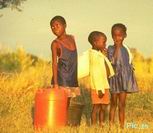
Daily, all around the globe, gravity pulls a life-giving substance from
the sky then drags it along the surface of the earth until it finds a resting
place above or below the ground. Thank goodness it does, for, all around
the globe, people need that life-giving substance for sustenance and survival.
After all, it's the liquid key to our existence: water.
In Africa, people get the water they need for every day living in a variety
of ways. In cities and towns, residents may have running water, hot and
cold, right in their homes. But, in many rural African villages, like Ochieng
and Atieno's, people have to use their feet - and their heads - to get
the wet stuff. In some villages, there are several community wells with
water pumps or taps. In others, springs and water holes are the source of
the life-giving liquid. Still others depend on lakes and rivers as regular
water supplies. They may get it from below, just others all around the globe
do, but that's only because gravity got it first - from on high.
Photo
#30 - Using your head - and your neck.
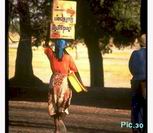
In Ochieng and Atieno's village, some people have to walk a long distance,
especially during the dry season, to get the water they need for every day
living. Of course, they have to carry that water all the way back home,
too! Some use donkeys, horses, cows or bikes to do the hauling - but most
just use their heads. Well, that's where the water bucket rests anyway.
They also use their necks, backs, legs and feet for support and strength.
And they must have excellent balance and a steady stride; after all, the
well-being of their families depend on it.
Photo
#31 - Double-load: water and child.

Ever have your hands full, a burden on your back and a load on your mind?
Most women in Ochieng and Atieno's village take great pride in their
ability to carry things on their heads. The thing a woman carries up there
most is water. But, she may also carry sticks for firewood and sometimes
produce for sale at the market. When going on a long trip, or moving to
the city, she may carry a big trunk full of her belongings. And that's
just on her head! At the same time, she may carry a baby on her back, a
basket in one hand and a bag in the other. Now, that might seem like an
oversized load, but she balances it gracefully.
Photo
#32 - Starting young: carrying firewood.
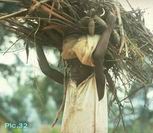
So, how do African women acquire this amazing skill of balancing large buckets
of water on their heads and walking long distances with them. Well, cooking
requires water, but it also requires fire. Many African families depend
on wood - often loose sticks and branches - for fire. Daily, young girls
and boys are sent to gather firewood, and they carry it back to their homes
on their heads. As they get older and stronger, they get better and better
at balancing and soon no longer need to use their hands.
Children also often help to carry water. Each child has a container that
matches his or her size. As they get older and stronger, they graduate to
larger containers - and when they can carry a large pail of water for a
mile or two without spilling any, not only have they reached the height
of their skill, but they don't get wet!
Imagine you are growing up in Ochieng and Atieno's village. On average,
you walk one mile to get water every day and you carry five gallons of water.
If you did this every day from age ten to age 60, how many miles would you
have walked and how many gallons of water would you have carried?
Photo
#33 - A family that works together.... survives the long dry season.

In Ochieng and Atieno's village, which is close to the equator and just
North of Lake Victoria, there are four seasons: the long rainy season, the
short rainy season, the long dry season, and the short dry season. Sometimes
the long dry season, which can last for three months or more in some years,
is especially challenging. In these difficult times, the whole family must
pull together to find water. Are there times when your family has to pull
together to complete a task that benefits everyone in your family?
Photo #34 - The cycle of life.
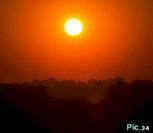
When rain returns to the land after a long
dry season, it's something like springtime. Green grass and flowers
that had long succumbed to the equatorial heat spring back to life and fill
the countryside with freshness and color. Termites take the air, birds flit
after them and many other animals become active once again. People, too,
start digging in the ground again to prepare a new crop, relieved and joyful
to know that life has returned to their land and they have survived the
harshness of another dry season.
Photo #35 - The many chores of Mom.
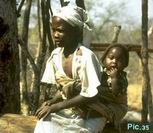
In Ochieng and Atieno's village, mothers typically wake up at the crack
of dawn and begin a series of chores which end when the last light is turned
off at night. Fetching water and firewood, preparing food, working in the
garden, and caring for children are just a few of the chores that fill a
woman's day.
If you worked every day from 6:00 A.M. till 9:00 P.M. with 2 hours break
for meals and rest, six days a week, how many hours a week would you work?
Photo
#36 - Tending the cassava.
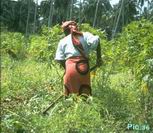
Many women in East Africa spend most of their days in the shamba
or garden. There, they tend to a variety of crops, most commonly, mahindi,
nyanya, kitungu, sukumawiki, njugu, muhogo and kiazi. In case you're
wondering, the English names of these Swahili words are, in order: corn,
tomatoes, onions, collard greens, peanuts, cassava, and potatoes.
Photo #37 - Job
number one: caring for the young.

The woman in this picture doesn't have to do all of the chores that
most women in her village have. That's because she is a teacher at the
local high school. She hires a maid to take care of her new baby girl during
the day. Still, she finds time to knit. She knitted the outfit her daughter
is wearing.
What other professions do you suspect women in Ochieng and Atieno's
village have besides teaching and caring for a home?
Photo
#38 - Helping the
hand that feeds you.
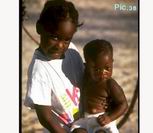
Children, of course, have chores around the house, too. When they are not
at school, children, especially girls since the boys may be off grazing
animals, help carry water and firewood, weed and water the garden, harvest
and prepare food and care for their younger siblings, just to name a few
tasks.
What jobs do you have to do around your home to help out?
Photo #39 - The
main labor force around the home: Mom.

Do you consider yourself to be a hard worker?
Try this: walk one mile to a water hole, then carry a large pail of water
on your head back to your house, grind some grain by hand, collect some
firewood from the land, boil some water, prepare a meal, feed six children
and a man, get the children ready for school, and dig for four hours in
your family's garden. Tired yet? Let's hope not, cause it's
only lunch time - which means, as the mother of a rural African household,
you have to get water, firewood and food again, then prepare the meal.
Photo #40 - Taking
a break at the market.
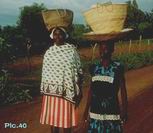
You might not think that carrying an empty
basket on your head for a mile or two, shopping and then carrying a full
basket on your head all the way home would be considered much of a break,
but going to the weekly market in town is a special event for most woman
in Ochieng and Atieno's village. Even though it's still work in
a way, a trip to the market is much easier than most of the work. Plus,
it's exciting. There are lots of things to buy, many people to visit
with and lots of things to see. (Read the next three 'Tell Me About
Its' for a more detailed description of the market.)
Photo
#41 - There's
lots to see and do in town on market day.
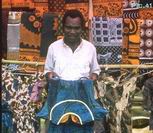
Imagine it's early in the morning on market-day in a typical East African
village and you are the first to arrive at the market. You park your bicycle
and start to walk towards the euphorbia and bougainvillea fence that surrounds
the market place. Just outside the fence, you see a row of small buildings
where cooks and fix-it men called fundis will soon set up shop. You
walk through the gate and see a large open-air area filled with lots of
small stands made out of wood and thatch. Some of the stands are covered
with tin or plastic for protection from rain. It's quiet, drab and still,
but soon the whole place will turn into an exciting scene of color and activity.
Photo
#42 - There's
lots to see and do in town on market day. (Continued
from previous 'Tell Me About It!')
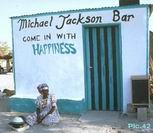
Standing in the empty market place, you hear a few women talking quietly
in the distance. As they near, you see that many others follow. They are
all carrying large baskets on their heads. They enter the gate, pass you
and begin to take items from their baskets - yellow bananas, white and brown
eggs, green collards, purple eggplants, orange papayas, red tomatoes, sunset-tinged
mangoes,shiny beans with a variety of hues - placing them neatly on the
stands. Suddenly, the market has become a colorful place! The raw foods
- cabbage, corn, millet, onions, peanuts, sesame seeds - of course, also
add their delicate fragrances to the atmosphere; but these are soon overwhelmed
by the rich wafts of home-style cooking rolling out from the sheds lining
one side of the market fence, and by the powerful stench arising from the
corner of the market where the fishermen have begun to display their latest
catch and the butchers proudly present their flanks and shanks of raw meat
and their gooey, glimmering mounds of viscera.
Photo
#43 - There's lots to see and do in town on market day. (Continued
from previous 'Tell Me About It! page.)

Soon a caravan of bicycles totters through the gait, overloaded with cargo
- a few carrying mounds of multi-colored clothing; others hauling fabricated
goods - pots and pans, plastic kitchenware and basins, lanterns, matches,
toys - and processed foods - cooking fat, flour, powdered milk, beer, soda,
sugar - imported from the city, and still others toting stylishly designed
crafts and homemade household items - baskets, clay pots, cooking stoves,
rope, wood carvings, jewelry. By now the people gathered are laughing and
talking loudly so they can be heard over the noise rising just outside the
fence on the opposite side of the market from the cooking sheds. There,
men and boys shout commands to a runaway train of bleating, mooing, grunting
and clucking domestic animals, trying to corral them into their designated
locations. Fundis, or 'fix-it men' add to the din as they begin
hammering nails and pounding metal, fixing bikes and shoes and stoves and
watches and cars and just about anything thing else that needs fixing.
Now, people from all over the area begin filing in and the market fills
with activity, excitement and energy. The people who have gathered haggle,
they gossip, they catch up with old friends, they laugh, they argue and
debate, they eat, - and they fill their baskets with the goods that will
sustain them until the next market day. Can you believe you are in the same
place that was so still and quiet at the beginning of the day?
Photo
#44 - Visiting the mill - and relatives.

In the village center where Ochieng and
Atieno live, there is a posho mill. At the mill, they have a machine run
by electricity which grinds grain into flour. Sometimes woman grind their
own flour using stones, but on market day they can pay a small fee and have
it ground at the mill. In the village center, there are also a few modern
style housing units - apartments. These are very different from traditional
Luo homes. Some of the teachers who work at the school live in the apartments
with their families. One family that lives in the apartments is related
to Ochieng and Atieno. Ochieng and Atieno like to visit their relatives
in the village center, but they are glad they don't have to live there
all the time. They prefer living in a homestead.
Photo
#45 - Buying candy at the store.
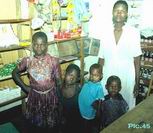
The village center also has a small shop
where people can buy food items like flour, bread and eggs, drinks like
soda, milk, tea and beer, and other necessities like matches, medicine and
soap; but Atieno's favorite item is the hard round candy they sell there!
Photo #46 - Market on the shore.
The weekly market in town is full of excitement, activity 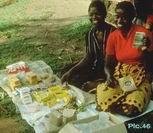 and
color. The daily market on the shores of the lake, on the other hand, is
only full of fish! Well, that's if the fishermen happen to find their
nets full when they check them first thing in the morning. Usually, they
have some luck and can often sell all their fish to gathering villagers
shortly after they haul in their catch and land their large handmade wooden
boats. The fishermen and villagers still haggle for the prices, a couple
young boys sell donut-like mandazi with tea, and a few women might
try to take advantage of the gathering by selling a handful of other items,
but, with the cool morning breeze and the sun still low in the sky sending
streaks of soft colors through the clouds, the atmosphere is much more relaxed
than that of the market in town.
and
color. The daily market on the shores of the lake, on the other hand, is
only full of fish! Well, that's if the fishermen happen to find their
nets full when they check them first thing in the morning. Usually, they
have some luck and can often sell all their fish to gathering villagers
shortly after they haul in their catch and land their large handmade wooden
boats. The fishermen and villagers still haggle for the prices, a couple
young boys sell donut-like mandazi with tea, and a few women might
try to take advantage of the gathering by selling a handful of other items,
but, with the cool morning breeze and the sun still low in the sky sending
streaks of soft colors through the clouds, the atmosphere is much more relaxed
than that of the market in town.
Photo
#47 - Famous for fishing.
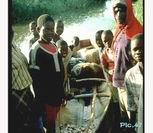
In Kenya, the Luo people - among the country's 40+ ethnic groups - are
famous for fishing. Several hundred years ago, their ancestors lived on
the banks of the Nile River in what is now called Sudan. There, they raised
some animals and crops - but were most skilled at fishing. In time, these
people migrated south and east, looking for new land - and new fishing waters.
Some settled further south on the Nile and others settled around the small
lakes of northeastern Uganda. Still others wandered further south and further
east until, at last, after crossing the equator, they found the mother of
all fishing spots - Lake Victoria - the largest lake in Africa. The Luo
eventually settled all around the northern and eastern shores of this great
lake and, to this day, carry on their longstanding tradition of catching
lots of fish!
Photo
#48 - The waves of modernity.

Centuries ago, the ancestors of the Luo people fished on the ancient Nile
River. These days the Luo still fish; but times have changed. The Luo of
today believe that a modern education is the best boat children can row
towards their future. While some children might never complete school because
they follow the tradition of fishing, most children go fishing only during
after-school hours or when they are on school holidays.
Photo #49 - Dressed for success, in the school
uniform.
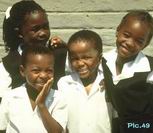
In the old days in Ochieng and Atieno's village, since the Luo people
were famous for fishing, many young people would aspire to be fishermen
or fisherwomen. So, they learned as much as they could about fishing at
the best place available - the lakeshore - and from the best teachers available
- the fishermen. But now that modernity has washed the shores of their village,
Luo children aspire to be a whole variety of different things, like teachers,
farmers, doctors, businesspeople, engineers and many more. So, now, instead
of hanging out at the lakeshore a lot, they spend most of their time at
school, and instead of learning from the fishermen, they gain skills and
knowledge from their teachers.
You might notice that at Ochieng and Atieno's village school, the children
have to wear uniforms. Do you wear uniforms at your school?
Photo
#50 - In front of the classroom: 2nd graders.

Ochieng and Atieno's school is shaped like a long train, with each classroom
like one car of the train. Every grade has its own classroom. There are
no hallways and no doors from one classroom to the next. Instead, each classroom
has its own door which students can enter from the outside of the building.
The walls of the one story school are made of cement blocks, the floor is
cement and the roof is made of tin sheets resting on a wooden frame. The
windows have metal panes that open to let the breeze go through. Some of
the windows don't have glass - but that hardly makes a difference since
it is always warm in their village near the equator. After all, under a
tin roof, a breeze sure feels good. Of course there are no snow days, but
sometimes when it rains, the noise of so many drops hitting the tin roof
is so loud that classes are suspended until the rain subsides.
How would you describe your school to Ochieng and Atieno?
Photo
#51 - Schoolwork takes.... concentration.
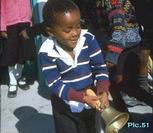
Even though your school may look different from Atieno and Ochieng's,
school, anywhere in the world, is all about the same thing: exercising your
brain! Ochieng and Atieno study a variety of subjects including Math (though
they call it 'Maths'), History and Government (sort of like Social
Studies), Science, Reading, Writing, English, Swahili, and Gym (they call
it P.E. which stands for Physical Education). Do those subjects sound familiar?
With the exception of Swahili, you probably have similar subjects. And,
to do well in them, you probably have to do the same thing Ochieng and Atieno
have to do in order to do well in theirs: concentrate!
Photo
#52 - After the work: recess!
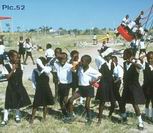
The school day at Atieno and Ochieng's school begins long before class
starts. From 7:00 to 8:00, they have a mandatory 'manual labor'
period. In other words, they work around the school compound. Some students
have to sweep classroom floors, others have to work in the school garden
and others have to mow the lawn - by hand using machete like tools called
'pangas.' Some students even have the job of supervising other students.
After the manual labor period, students gather at 8:00 sharp around the
flagpole for the morning assembly. There, announcements are made, the national
anthem sung, punishments levied (for students who were late or didn't
do their required manual labor, for example) and motivating words imparted.
Classes then begin at 8:15. At 10:15, students get a 15 minute break, then
classes resume until noon. Lunch break extends from 12:00 to 1:30 since
many students walk home for lunch and their homes are a long distance away.
After lunch, classes go until 3:00.
Then, finally, after all that work, the students get a chance to play! From
3:00 to 4:00, students have games' time. Some use this time to practice
for sports or clubs, and others just play whatever they like, jumprope,
kati (a game combining monkey in the middle and dodgeball rules, using bottlecaps),
netball, volleyball, soccer, or basketball. Sound like fun? What games
do you play at recess?
Photo
#53 - Homework and work at home.

With such a full day at school - and such a long walk home after school
(some students live 2 miles or more from the school), the teachers don't
often give a lot of homework at Ochieng and Atieno's school. Sometimes
they do, though, especially when exam time is approaching. Besides any school
homework they get, though, students have lots of other chores to do around
the home when they get home from school. They often have to go to the village
well for water, find firewood, care for animals, work in their family garden,
babysit their younger siblings and more. That's lots of home work!
Do you get lots of homework? What responsibilities do you have in addition
to your schoolwork?
Photo
#54 - Playtime: out for a ride around town.
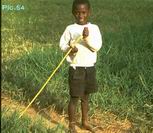
Finally, when all the school work is done and all the homework is done and
all the work around home is done, children play! One of Ochieng's favorite
games is going for a drive. Attached to a long stick by a nail, he has a
small wheel-shaped piece of rubber which he cut out of a worn out sandal.
This is his 'car' - or at least that's what he calls it. For
fun, he takes his car out and wheels it around the village, sometimes encountering
other drivers his age and sometimes passing other children playing, like
the boys playing soccer in the background of this picture.
Photo
#55 - Time to go: have a 'push.'
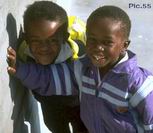
Your field trip to Ochieng and Atieno's village is nearing its end.
It's almost time to go. When visitors leave Luo homes , the hosts almost
always give them a 'push!' Don't worry, this kind of 'push'
is an act of kindness, a traditional way of showing respect and softening
the sadness of departure. As you walk from Ochieng and Atieno's home
towards the next village, they'll walk with you for the first part of
the way, chatting with you as you go. That's the 'push' - sort
of a friendly 'boost' to get you going and a final reminder of the
graciousness of your hosts; a way of saying 'Thanks for coming - hope
you come again!'
Photo
#56 - Friendship - around the world.
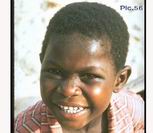
One thing about children, whether they are from a small village in East
Africa, a rain forest community in the Amazon, or a large city in the U.S.,
they love to play. By playing with neighbors, children often make friendships,
sometimes friendships that last a lifetime. Through friends, children often
learn neat new things about themselves and about their world.
Who are your best friends? What things do you play with them? What neat
new things have you learned from your friends?
Imagine if each country in the world were one house in one neighborhood?
You could knock on a different door each day and make new friends from around
the world and you would learn so many neat new things. Which doors would
you knock on first?
Photo
#57 - From a distance.....

From on top of the rocks behind Ochieng and Atieno's school, you can
see the whole area that surrounds their village. On the rolling, rock-covered
hills, between the bushes and the trees, you might see a few homesteads
and herds of animals and people walking around. You could probably tell
that the people there were farmers and maintained, to some degree, a traditional
lifestyle. But, unless you climbed down and went in their homes, sat in
their guest houses, and visited the village market, the lakeshore and the
school with them - like you just did - you probably wouldn't really
get to know them very well. Now that you have gone on a field trip all through
the village, though, you've gotten to know Ochieng and Atieno
quite well and, in a way, you've made some new friends around the world.
Photo
#58 - Africa: a wide and wonderful place.

Africa is truly a wide and wonderful place. It has (including some of its
islands) as many countries as the United States has states. It is so large
that the continental United States could fit inside it three times. In fact,
though Africa has several large deserts, the U.S. could almost fit in just
one of them! Of course, that desert is the Sahara - the largest in the world.
But Africa isn't all hot and dry. It also has the longest river in the
world - the Nile - and the one that holds the most water, the mighty Congo;
plus the Great Rift Valley and its own set of 'Great Lakes.' And
that's not all....
Photo
#59 - Africa: a unique blend of beauty.
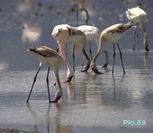
Africa is also famous for its beauty. It has famous historical and archeological
sites, like the pyramids and the Olduvai Gorge just to name a couple; it
has ocean shorelines, tropical islands and modern cities; it has snow-capped
mountains, lush green highlands and sprawling grasslands. And, of course,
it has an impressive roster of some of the world's most incredible exotic
animals. But, still, that's not all......
Photo #60 - Africa: a unique blend of beautiful
people.
 So, Africa is a huge and beautiful continent - but probably its most remarkable
asset is its people. You met Luo people in this trip to East Africa. But,
the Luo are only one of more than forty different ethnic groups in Kenya.
Each has its own language and traditional beliefs and customs. So, Kenya
is a very diverse country - but Africa on the whole is incredibly diverse.
According to some linguists, for example, the continent of Africa, is home
to people who speak more than one thousand different languages. You visited
one small village in Africa and learned about how the people there live,
but keep in mind that, across Africa, there are many, many different ways
of life. And while those different ways of life include some things that
may be very different from the things in your life, remember too that, despite
all the differences, people around the world also have many things in common.
So, Africa is a huge and beautiful continent - but probably its most remarkable
asset is its people. You met Luo people in this trip to East Africa. But,
the Luo are only one of more than forty different ethnic groups in Kenya.
Each has its own language and traditional beliefs and customs. So, Kenya
is a very diverse country - but Africa on the whole is incredibly diverse.
According to some linguists, for example, the continent of Africa, is home
to people who speak more than one thousand different languages. You visited
one small village in Africa and learned about how the people there live,
but keep in mind that, across Africa, there are many, many different ways
of life. And while those different ways of life include some things that
may be very different from the things in your life, remember too that, despite
all the differences, people around the world also have many things in common.
Photo
#61 - A smile is a great universal expression.
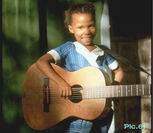
The ability to smile is something that all people have in common. And, all
around the world, no matter what language the person smiling speaks, what
religion she belongs to, or what traditions and customs he follows,
a smile carries the same universal message.
How would you put into words the meaning behind a smile?
Photo
#62 - All are special and all are unique.
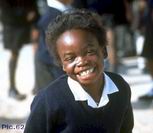 Are you special? Are you unique? Of course you are! And, though there may
be many, every child all around the world is special; and every child all
around the world is unique - and that's amazing!
Are you special? Are you unique? Of course you are! And, though there may
be many, every child all around the world is special; and every child all
around the world is unique - and that's amazing!
GO
HOME FOR MORE LINKS
PAGE INDEX
| CURRICULUM CONNECTIONS | TELL
ME ABOUT IT
Photo Credits: Lara Held, Dennis Pippen, Frank Hurteau,
Paul Hurteau, Mike Armstrong, Helen Snook and Missionaries of Africa. Design:
Lilia Cai-Hurteau.
© 2007 OneWorld Classrooms. All rights reserved.

